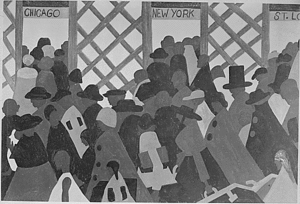
English: Painting “During World War I there was a great migration north by southern Negroes”. Panel 1 from Migration of the Negro, 1940-1.http://stage.phillipscollection.org/research/american_art/artwork/Lawrence-Migration_Series1.htm (Photo credit: Wikipedia)
Yesterday, we completed another one of our quarterly road trips – twelve hours in all. Straight through. And as I suggested yesterday, we never gave a thought about where we had to eat or use the restroom. The reality of life in 2013 is that green –money–speaks and allows for smooth uneventful travel–for the most part.
This was not always reality for African Americans who might have chosen the road over the rail in the early part of the century. And an enterprising man in the 1930’s, Victor H. Green, a postal worker, used his connections to come up with The Negro Motorist Green Book, also known as The Green Book. The Green Book gave Negroes peace of mind to allow them to know where they might stay overnight and find places to eat as they were on the road. Traveling musicians and players in the Negro leagues made great use of the informaiton, but it was for everyone. On the cover of the 1949 edition, it comes with the tagline “Carry your Green Book with you. You may need it.” There was no need to explain to Negroes who lived at that time what going without such a useful guide meant.
The characters in my Golden Heart nominated story, A Champion’s Heart, don’t have The Green Book available to them and serves as part of the difficulty, as well as a bonding force for my hero and heroine. Victor Green did not start publishing this guide until 1936 and Champ and Delie made their trip northward in 1935. They had to rely on Champ’s contacts from his vagabond days as a ham and egger boxer to find shelter and food for themselves and four orphan children. Victor Green knew that the whole point of his publishing the guide was to put minds at ease. But his whole purpose was to be put out of business. He felt travel helped with that end goal, which happened thirty years later when he stopped publishing the book. He wanted to encourage travel, because, as it says on the cover “Travel is fatal to prejudice.”
The existance of this travel guide is not discussed often as part of African American history, but should serve as a reminder of the difficulties of early road travel. There has been an adult play, a children’s book and even a puppet show, but more people should know about The Green Book so that they can appreciate how smoothly twelve hours can pass on the road.
Here’s a link to the 1949 version. http://www.autolife.umd.umich.edu/Race/R_Casestudy/87_135_1736_GreenBk.pdf
Does the existance of such a travel guide surprise you?
